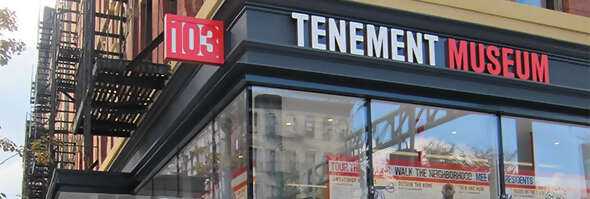THEN AND NOW New York Museum brings a different perspective to illegals and terrorists
Posted on 10/18/2016 | About New York-Northern New Jersey-Long Island, New York

In millions of places across the country this election year, Americans are having heated debates about foreigners - the potential terrorists, religious radicals and illegal immigrants. But step into the time portal of New York's Tenement Museum and meet the scary strangers of earlier years who were Irish, Italian and German.
Walk on its faded carpets and wander across the ages into the recreated homes of immigrant families named Moore, Baldizzi and Gumpertz.
This year, present and past are colliding here. During group tours, old stories are triggering new debates as modern-day political passions sweep the rickety hallways of this low-rise on the Lower East Side.
The museum has held special workshops for staff - to help guides encourage respectful dialogue.
“Conversations can get heated,” says one guide, Kathleen Fletcher. “In this last year I've probably had people bring up the modern day more often than in four previous years here.”
One thing that riles visitors sometimes: Comparing their ancestors to today's immigrants.
Consider old calumnies about the Irish - religious fanatics, antagonistic to secular democracy, beholden to foreign spiritual leadership in Rome, and very violent as evidenced by the 119 people killed when a mob torched buildings, attacked blacks and rioted over the Civil War military draft in 1863.
Visitors are shown old newspaper cartoons depicting Irish men and women as big brutes. They hear a song titled after the era's racist job postings: “No Irish Need Apply.” They also hear about political organizations, like the notorious Tammany Hall, which catered to Irish voters.
Guide Kathleen Fletcher recalls asking one tour group if anyone detected any similarities.
Someone immediately interjected: “Some guy just spoke up and said, 'No.'
“'He said, 'The Syrians are different. They're coming here to hurt us. We don't know who they are.'
“He was quite angry and really did not accept that this story was in any way similar - because of the terrorism issue and we didn't have to deal with that back then.”
Some Italians react similarly to other comparisons.
A century ago people didn't just fear Italian terrorism.
Followers of anarchist Luigi Galleani planted dozens of bombs in the US, touching off the Red Scare of 1919. One visiting Italian scholar on migration told Fletcher how he reads his students old US newspaper passages about violent foreigners.
Fletcher said: “He'll usually get responses like, 'Oh, those are Muslims. Those are the refugees.' ... (The professor replies), 'No - that's actually what they were saying about our people 80 years ago.”'
There's another long-forgotten fact that might surprise the numerous Italians serving in senior positions on Republican nominee Donald Trump's campaign - whose centrepiece is a crackdown on illegal immigration, with increased deportation.
Many Italians entered the US illegally too.
They include the woman who raised a family in what's now the museum. Julius Baldizzi intended to bring his wife from Sicily after saving some money. But the US passed a 1924 law that banned immigrants from most Asian and Arab countries, and almost totally banned it from certain other countries including Italy.
So Rosaria Baldizzi was smuggled in.
Relatives later recalled her weeping frequently because she missed her Mediterranean homeland. Years later she was granted amnesty, left the country and re-entered legally through Canada. Her descendants have fought for the US in wars, served as New York police officers and provided historical documents that helped develop the Tenement Museum.
But one museum visitor of Italian origin bristled at a certain modern comparison. The woman recalled her people being insulted as “wops” - a slur originating in an anodyne acronym for “Without Papers.”
Fletcher asked if any modern slur compared.
“I said, 'What about calling people 'illegals'? ... And she said, 'No, no, not at all, it's not the same.”'
So Fletcher mentioned an undocumented person she knows from Ireland, and asked: “When people say 'illegal immigrant,' do you think they are imagining my Irish (friend)?' She was kind of silent, and then she said, 'Ohhhh. No, maybe not.”'
The museum is set to add newer chapters of America's immigration story.
It's expanding to a second building and will recreate apartments of Holocaust survivors, Puerto Ricans and Chinese people. The original building stopped being used for housing in 1935. Its upstairs apartments were sealed off, preserving old layers of wallpaper, flooring and antique fixtures.
Guide Judy Levin said she's working harder, and listening more attentively these days. Fletcher, meanwhile, welcomes the collision of past and present conversations.
“I want there to be dialogue,” she said.
“I love when people will bring up issues of today... I love it, I love it.”





